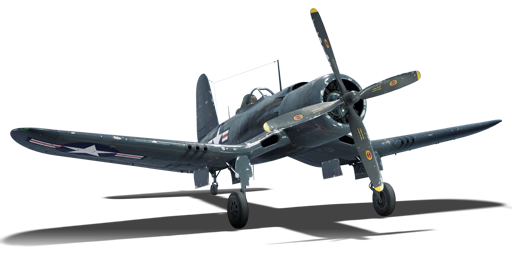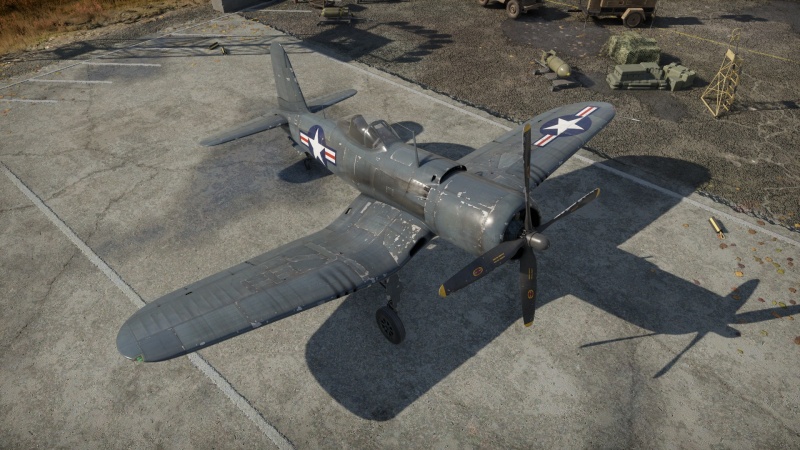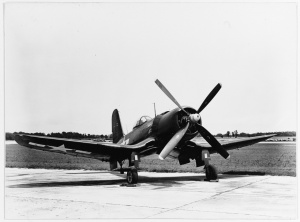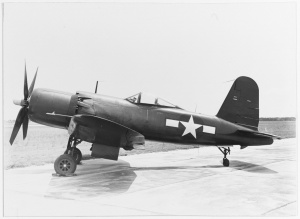F2G-1
Contents
Description
The F2G-1 "Super Corsair" is a premium gift rank American fighter with a battle rating of (AB), (RB), and (SB). It was introduced during Update "New Power" as a reward for Battle Pass: Season I. The Super Corsair was a development made by Goodyear, a licensed manufacturer of the Vought F4U Corsair. The Super Corsair was intended by Goodyear as a low altitude fighter.[1] Powered by the Pratt & Whitney 28 cylinder R-4360 Wasp Major engine, nicknamed the "Corncob," the Super Corsair made 3000 hp. By the time the Super Corsairs was ready for production the Grumman F8F "Bearcat" was already being built and had similar performance. Partially due to this, only 10 Super Corsairs were ever completed, 5 of which were the F2G-1 land variant found in game.[1]
General info
Flight performance
| Characteristics | Max Speed (km/h at 5,000 m) |
Max altitude (metres) |
Turn time (seconds) |
Rate of climb (metres/second) |
Take-off run (metres) | |||
|---|---|---|---|---|---|---|---|---|
| AB | RB | AB | RB | AB | RB | |||
| Stock | ___ | ___ | __._ | __._ | __._ | __._ | 180 | |
| Upgraded | 740 | 706 | 20.1 | 21.0 | 27.0 | 20.0 | ||
Details
| Features | ||||
|---|---|---|---|---|
| Combat flaps | Take-off flaps | Landing flaps | Air brakes | Arrestor gear |
| ✓ | ✓ | ✓ | X | X |
| Limits | ||||||
|---|---|---|---|---|---|---|
| Wings (km/h) | Gear (km/h) | Flaps (km/h) | Max Static G | |||
| Combat | Take-off | Landing | + | - | ||
| 382 | 324 | 248 | ~10 | ~5 | ||
| Optimal velocities (km/h) | |||
|---|---|---|---|
| Ailerons | Rudder | Elevators | Radiator |
| < 540 | < 250 | < 500 | > 440 |
Survivability and armour
- 38 mm bulletproof glass - Windscreen
- 12.7 mm steel - Pilot's headrest
- 8 mm steel - Pilot's seat
- 3 mm steel in front of pilot
Modifications and economy
Armaments
Offensive armament
The F2G-1 is armed with:
- 6 x 12.7 mm M2 Browning machine guns, wing-mounted (300 rpg = 1,800 total)
Suspended armament
The F2G-1 can be outfitted with the following ordnance:
- Without load
- 2 x 250 lb AN-M57 bombs (500 lb total)
- 2 x 500 lb AN-M64A1 bombs (1,000 lb total)
- 2 x 1,000 lb AN-M65A1 bombs (2,000 lb total)
- 8 x HVAR rockets
- 2 x Tiny Tim rockets
Usage in battles
Describe the tactics of playing in the aircraft, the features of using aircraft in a team and advice on tactics. Refrain from creating a "guide" - do not impose a single point of view, but instead, give the reader food for thought. Examine the most dangerous enemies and give recommendations on fighting them. If necessary, note the specifics of the game in different modes (AB, RB, SB).
Manual Engine Control
| MEC elements | ||||||
|---|---|---|---|---|---|---|
| Mixer | Pitch | Radiator | Supercharger | Turbocharger | ||
| Oil | Water | Type | ||||
| Not controllable | Controllable Auto control available |
Controllable Auto control available |
Controllable Auto control available |
Separate | Not controllable 1 gear |
Not controllable |
Pros and cons
Pros:
- Great initial climb rate and acceleration for a propeller plane
- Six .50 cal machine guns can easily deal with any aircraft in its sights
- Very strong landing gear can survive speeds of over 700km/h and be used as an airbrake
- Can enter WEP without overheating for much longer than either of the F8F variants
- High-rank premium vehicle that can help research other vehicles and gain Silver Lions
Cons:
- Lacks engine power at higher altitudes
- Often uptiered to face F-84Gs and similar aircraft
- Like other Corsairs, the F2G-1s flaps rip at relatively slow speeds
- Compresses at higher speeds, which are necessary to catch most opponents
History
| The F2G Corsair is often referred to as "Super Corsair", though that was never an official designation. |
Genesis
Pratt & Whitney fitted an F4U-1 Corsair (Bu.No. 02460) - donated to them by the Navy - with their R-4360-4 Wasp Major engine in March 1943. The P&W R-4360-4 Wasp Major engine put out approximately 50% more power than the original P&W R-2800-1 Double Wasp used in other Corsairs; the 28-cylinder R-4360-4 was able to produce 3,000 horsepower. The F4U-1 fitted with the R-4360-4 was designated as F4U-1WM, and it was proven as a success after testing. As such, development of a production Corsair fitted with the R-4360 was given to Goodyear on 22 March 1944, when the Navy ordered 418 F2G-1 Corsairs and 10 F2G-2 Corsairs (a navalized variant with carrier capability).
Development
Seven prototypes were built and designated as XF2G-1, being modified production FG-1 Corsairs (a Goodyear-produced, fixed wing "de-navalized" version of the Corsair). The first XF2G-1 (Bu.No. 13471) was fitted with the R-4360 engine but retained many characteristics of the standard Corsair, including the canopy and cockpit, though the engine cowling was extended and an air scoop was added on top of the fuselage right behind the engine cowling. It began ground testing on 31 May 1944, and first flew on 26 August of the same year. The second XF2G-1 (Bu.No. 13472) was used to test new aspects including oil coolers and propellers, which would be used on later XF2G-1s.
The remaining five prototypes (Bu.Nos. 14691 through 14695) were modified much more extensively. They featured a new bubble canopy and a reduced spine, in order to provide better visibility to the pilot. Additionally, the cockpit was redesigned; it received a floor and new controls quite similar to those used on the Vought F4U-4 version of the Corsair. The XF2G-1 retained the six .50 cal (12.7 mm) machine guns of the FG-1 as well as the same ordnance carrying capability, but they were modified to allow the carrying of external, jettisonable fuel tanks for extended range.
Bu.No. 14691 used the engine taken from the first prototype, Bu.No. 13471, and it first flew on 15 October 1944. Bu.No. 14692 added wing-mounted fuel tanks and improved vertical control surfaces. Bu.No. 14693 was fitted with the R-4630-4W version of the R-4630 engine, which introduced water-ethanol injection for increased power, but the -4W version of the engine was not fitted to any other version of the F2G. The final XF2G-1, Bu.No. 14695, had its first flight on 4 December 1944, but was wrecked in the hangar soon after by a crane and was not repaired.
On 27 November 1944, the XF2G-1 was given to the U.S. Navy for testing. Some issues arose during testing, particularly that the engine torque of the engine would cause the aircraft to turn hard to the left in a carrier wave off (when increasing the throttle in the case that the landing had to be aborted). In the case of a wave off and the throttle being applied, the rudder was not able to prevent the nose swinging to the left. To prevent this effect, the rudder was heightened by twelve inches and an auxiliary rudder was installed beneath it which would automatically turn 12.5 degrees to the right when the landing gear was extended, in order to counteract the torque of the engine.
Production
The first production F2G-1 (Bu.No. 88454) was delivered to the Navy on 15 July 1945, but the contract for production had been cut down to only five F2G-1 and five F2G-2 two months earlier in May. Production therefore ended in August 1945 after only 5 F2G-1 (Bu.Nos. 88454 through 88458) and and 5 F2G-2 (Bu.Nos. 88459 through 88463) had been produced, for a total of eighteen F2G aircraft built of all variants, including the F4U-1WM. The Navy continued testing of the F2G series after production cancellation but dropped the F2G completely soon after.
Production of the F2G had been cancelled due in part to disappointing test results. The F2G-1 had an impressive climb rate of 4,400 feet per minute, but its top speed of 430 mph (692 km/h) was rather disappointing, and it also had some stability issues. Overall, its performance wasn't a large enough improvement over other aircraft in production, particularly the F4U-4 and F8F-1 Bearcat, which is why the production orders for the F2G were cancelled.
Post-War Use - Racing
The F2G was much more successful post-war, many of the aircraft having served well as air racing aircraft, the most famous of which being the fifth production F2G-1 (Bu.No. 88458) known as "Race 57", famous for its bright red color scheme. Bu.No. 88463, the last F2G-2 produced, was also a racing aircraft known as "Race 74" and painted dark blue. Race 74 was destroyed in a crash in 2012 that also killed the pilot, Bob Odegaard. Only two F2G aircraft survive as of January 2021, which are the aforementioned Bu.No. 88458 "Race 57" and Bu.No. 88454, both F2G-1s.
List of F2G Aircraft
F4U-1WM
- Bu.No. 02460
XF2G-1
- Bu.No. 13471
- Bu.No. 13472
- Bu.No. 14691
- Bu.No. 14692
- Bu.No. 14693 - "Race 94"
- Bu.No. 14694 - "Race 18"
- Bu.No. 14695
F2G-1
- Bu.No. 88454 - N/A - Display, Museum of Flight, Seattle, Washington
- Bu.No. 88455
- Bu.No. 88456
- Bu.No. 88457 - "Race 84"
- Bu.No. 88458 - "Race 57" - Flightworthy, Louise M. Thaden Airfield, Bentonville, Arkansas (owned by Steuart Walton)
F2G-2
- Bu.No. 88459
- Bu.No. 88460
- Bu.No. 88461
- Bu.No. 88462
- Bu.No. 88463 - "Race 74"
Note: There was an aircraft named Super Corsair and later "Race #1" , which despite the name was not an F2G. It was an F4U-1D fitted with the R-4360 engine, clipped wings, and a modified cockpit.
Media
See also
Links to the articles on the War Thunder Wiki that you think will be useful for the reader, for example:
- reference to the series of the aircraft;
- links to approximate analogues of other nations and research trees.
External links
References
| USA fighters | |
|---|---|
| P-26 Peashooter | P-26A-33 · P-26A-34 · P-26A-34 M2 · P-26B-35 |
| P-36 Hawk | P-36A · Rasmussen's P-36A · P-36C · ○P-36C · P-36G |
| P-39 Airacobra | P-400 · P-39N-0 · P-39Q-5 |
| P-40 | P-40C · P-40E-1 · P-40E-1 TD · P-40F-10 |
| P-43 Lancer | P-43A-1 |
| P-47 Thunderbolt | P-47D-22-RE · P-47D-25 · P-47D-28 · P-47M-1-RE · ⋠P-47M-1-RE · P-47N-15 |
| P-51 Mustang | P-51 · P-51A (Thunder League) · P-51C-10 · P-51D-5 · P-51D-10 · P-51D-20-NA · P-51D-30 · P-51H-5-NA |
| P-63 Kingcobra | P-63A-5 · P-63A-10 · P-63C-5 · ␠Kingcobra |
| Prototypes | XP-55 |
| F2A Buffalo | F2A-1 · Thach's F2A-1 · F2A-3 |
| BF2C | BF2C-1 |
| F3F | F3F-2 · Galer's F3F-2 |
| F4F Wildcat | F4F-3 · F4F-4 |
| F4U Corsair | F4U-1A · F4U-1A (USMC) · F4U-1D · F4U-1C · F4U-4 · F4U-4B · F4U-4B VMF-214 · F2G-1 |
| F6F Hellcat | F6F-5 · F6F-5N |
| F8F Bearcat | F8F-1 · F8F-1B |
| Other countries | ▃Ki-43-II · ▃Ki-61-Ib · ▃A6M2 · ▃Bf 109 F-4 · ▃Fw 190 A-8 · ▃Spitfire LF Mk IXc |
| USA premium aircraft | |
|---|---|
| Fighters | Thach's F2A-1 · Galer's F3F-2 · F2G-1 · F4U-4B VMF-214 · P-26A-34 · Rasmussen's P-36A · P-40C · P-43A-1 |
| P-47M-1-RE · ⋠P-47M-1-RE · P-51A · P-51D-10 · P-51D-20-NA · ␠Kingcobra · XP-55 | |
| ▃A6M2 · ▃Ki-43-II · ▃Ki-61-Ib · ▃Bf 109 F-4 · ▃Fw 190 A-8 · ▃Spitfire LF Mk IXc | |
| Twin-engine fighters | XP-38G · Bong's P-38J-15 · P-38K · YP-38 · P-61A-11 · XF5F · XP-50 · F7F-3 |
| Jet fighters | P-59A · F-86F-35 · F-89B · F-89D · F-4S Phantom II · F-5C · F-20A |
| Strike aircraft | A-1H · A2D-1 · AU-1 · XA-38 · AV-8A · AV-8B (NA) · A-6E TRAM · A-10A |
| Bombers | A-26C-45DT · B-10B · BTD-1 · PBM-3 "Mariner" · PBM-5A "Mariner" · PV-2D |








